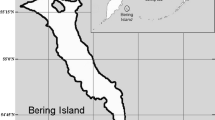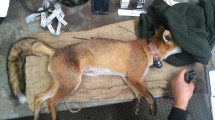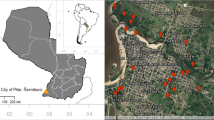Abstract
Urban areas provide small carnivores with an abundance of resources and reduced predation risk, resulting in higher population densities. Urban animals tend to have greatly reduced home range sizes in response to increased resource availability. We investigated the home range size of yellow mongooses Cynictis penicillata in an urban area and determined whether their home ranges overlapped with human residential areas. We studied the home range sizes of 8 collared and GPS tracked individuals in the Meyersdal Nature Area in South Africa; an area divided into two residential wildlife estates (4 individuals per estate): an Eco-Estate that was a built up residential area interspersed with natural areas; and a Nature Estate with reduced contact between animals and human residential areas. We used three methods to calculate home range size, namely Minimum Convex Polygon, Kernel Density Estimates and Local Convex Hull. Home range size was slightly larger in the Nature Estate, and male home ranges were larger than those of females. Compared to previous studies, home range sizes were considerably smaller in our study. Seasonal variation in home range could not be statistically compared, but, similar to non-urban populations, we observed smaller home range sizes during the breeding season (winter and spring) and larger sizes during the non-breeding season (autumn and summer). The overlap of home ranges with residential areas, and the record of multiple GPS fixes of tracked individuals within human residential gardens, was evident in both estates but to a greater extent in the Eco-Estate. Seasonal overlap with residential areas was greatest during autumn and winter. We showed that yellow mongooses modify their home ranges in response to urbanisation, which might be a consequence of abundant and easily accessible available resources, particularly during colder periods.


Similar content being viewed by others
References
Adam AMA, Rudolf K, Viliam P (2015) Differences in evaluation of three different approaches in home range sizes of red deer Cervus elaphus in Western Carpathians. For J 61:12–18
Balmforth ZE (2004) The demographics, spatial structure and behaviour of the yellow mongoose, Cynictis penicillata, with emphasis on cooperative breeding. Doctoral dissertation, University of Sussex
Bateman PW, Fleming PA (2012) Big city life: carnivores in urban environments. J Zool 287:1–23
Blaum N, Rossmanith E, Fleissner G, Jeltsch F (2007) The conflicting importance of shrubby landscape structures for the reproductive success of the yellow mongoose (Cynictis penicillata). J Mammal 88:194–200
Boyle S.A, Lourenço WC, Da Silva LR, Smith AT (2009) Home range estimates vary with sample size and methods. Folia Primatol 80:33–42
Calenge C (2006) The package adehabitat for the R software: a tool for the analysis of space and habitat use by animals. Ecol Model 197:516–519
Cavallini P (1993) Spatial organization of the yellow mongoose Cynictis penicillata in a coastal area. Ethol Ecol Evo 5:501–509
Chirima GJ, Owen-Smith N (2017) Comparison of kernel density and local convex hull methods for assessing distribution ranges of large mammalian herbivores. T GIS 21:359–375
Cronk NE, Pillay N (2018) Food choice and feeding on carrion in two African mongoose species in an urban environment. Acta ethol 21:127-136
Cronk N, Pillay N (2019a) Dietary overlap of two sympatric African mongoose species in an urban environment. Mammalia 83:428–438
Cronk NE, Pillay N (2019b) Flexible use of urban resources by the yellow mongoose Cynictis penicillata. Animals 9(7):447
Dahle B, Støen OG, Swenson JE (2006) Factors influencing home-range size in subadult brown bears. J Mammal 87:859–865
Fuller TK, DeStefano S, Warren PS (2010) Carnivore behavior and ecology, and relationship to urbanization. In: Gehrt SD, Riley SPD, Cypher BL (eds) Urban carnivores: ecology, conflict, and conservation. Johns Hopkins University Press, Baltimore, Maryland, USA, pp 13–19
Gaston KJ, Warren PH, Thompson K, Smith RM (2005) Urban domestic gardens (IV): the extent of the resource and its associated features. Biodivers Conserv 14:3327–3349
Gehrt SD, Fritzell EK (1997) Sexual differences in home ranges of raccoons. J Mammal 78:921–931
Gehrt SD (2007) Ecology of coyotes in urban landscapes. In: wildlife damage management conferences proceedings (paper 63), University of Nebraska, Lincoln, USA
Gehrt SD, Anchor C, White LA (2009) Home range and landscape use of coyotes in a metropolitan landscape: conflict or coexistence? J Mammal 90:1045–1057
Genovesi P, Sinibaldi I, Boitani L (1997) Spacing patterns and territoriality of the stone marten. Can J Zool 75:1966–1971
Germain E, Benhamou S, Poulle ML (2008) Spatio-temporal sharing between the European wildcat, the domestic cat and their hybrids. J Zool 276:195–203
Getz WM, Fortmann-Roe S, Cross PC, Lyons AJ, Ryan SJ, Wilmers CC (2007) LoCoH: nonparameteric kernel methods for constructing home ranges and utilization distributions. PLoS One 2:e207
Gilchrist JS, Otali E (2002) The effects of refuse-feeding on home-range use, group size, and intergroup encounters in the banded mongoose. Can J Zool 80:1795–1802
Gould NP, Andelt WF (2013) Effect of anthropogenically developed areas on spatial distribution of island foxes. J Mammal 94:662–671
Gregory T (2017) Home range estimation. In: the international encyclopedia of primatology (eds) Bezanson M, MacKinnon KC, Riley E, Campbell CJ, et al. https://doi.org/10.1002/9781119179313.wbprim0177
Grinder MI, Krausman PR (1998) Ecology and management of coyotes in Tucson, Arizona. Proceedings of the Vertebrate Pest Conference 18:293–298
Grueter CC, Li D, Ren B, Wei F (2009) Choice of analytical method can have dramatic effects on primate home range estimates. Primates 50:81–84
Harless ML, Walde AD, Delaney DK, Pater LL, Hayes WK (2010) Sampling considerations for improving home range estimates of desert tortoises: effects of estimator, sampling regime, and sex. Herpetol Conserv Bio 5:374–387
Hemson G, Johnson P, South A, Kenward R, Ripley R, Macdonald D (2005) Are kernels the mustard? Data from global positioning system (GPS) collars suggests problems for kernel home-range analyses with least-squares cross-validation. J Anim Ecol 74:455–463
Herr J (2008) Ecology and behaviour of urban stone martens (Martes foina) in Luxembourg. University of Sussex, Brighton, UK, Doctoral Thesis
Huck M, Davison J, Roper TJ (2008) Comparison of two sampling protocols and four home-range estimators using radio-tracking data from urban badgers Meles meles. Wildlife Biol 14:467–478
Kie JG (2013) A rule-based ad hoc method for selecting a bandwidth in kernel home-range analyses. Animal Biotelemetry 1:13
Le Roux A (2007) Communication in the yellow mongooses, Cynictis penicillata. Doctoral thesis. University of Stellenbosch, South Africa
Le Roux A, Cherry MI, Manser MB (2008) The effects of population density and sociality on scent marking in the yellow mongoose. J Zool 275(33):40
Lichti NI, Swihart RK (2011) Estimating utilization distributions with kernel versus local convex hull methods. J Wildl Manag 75:413–422
López-Sepulcre A, Kokko H (2005) Territorial defense, territory size, and population regulation. Am Nat 166:317–329
Mbatyoti OA (2012) Spatio-temporal ecology of the yellow mongoose Cynictis penicillata in the Great Fish River Reserve. Masters Thesis, University of Fort Hare, Eastern Cape, South Africa
McKinney ML (2008) Effects of urbanization on species richness: a review of plants and animals. Urban Ecosyst 11:161–176
Murray M, Cembrowski A, Latham ADM, Lukasik VM, Pruss S, St Clair CC (2015) Greater consumption of protein-poor anthropogenic food by urban relative to rural coyotes increases diet breadth and potential for human–wildlife conflict. Ecography 38:1235–1242
Nel JAJ, Kok OB (1999) Diet and foraging group size in the yellow mongoose: a comparison with the suricate and the bat-eared fox. Ethol Ecol Evol 11:25–34
Nilsen EB, Pedersen S, Linnell JD (2008) Can minimum convex polygon home ranges be used to draw biologically meaningful conclusions? Ecol Res 23:635–639
Poessel SA, Breck SW, Teel TL, Shwiff S, Crooks KR, Angeloni L (2013) Patterns of human-coyote conflicts in the Denver metropolitan area. J Wildl Manag 77:297–305
Poessel SA (2015) Ecology and behavior of coyotes in urban environments at varying spatial scales. Utah State University, Logan, Utah, USA, Doctoral Thesis
Powell RA (2000) Animal home ranges and territories and home range estimators. Research techniques in animal ecology: controversies and consequences 1:476
R Core Team R (2019) R: a language and environment for statistical computing. R Foundation for Statistical Computing, Vienna
Randa LA, Yunger JA (2006) Carnivore occurrence along an urban-rural gradient: a landscape-level analysis. J Mammal 87:1154–1164
Rasa OAE, Wenhold BA, Howard P, Marais A, Pallett J (1992) Reproduction in the yellow mongoose revisited. S Afr J Zool 27:192–195
Rautio A, Valtonen A, Kunnasranta M (2013) The effects of sex and season on home range in European hedgehogs at the northern edge of the species range. Ann Zool Fenn 107-123
Riley SPD, Sauvajot RM, Fuller TK, York EC, Kamradt DA, Bromley C, Wayne RK (2003) Effects of urbanization and habitat fragmentation on bobcats and coyotes in southern California. Conserv Biol 17:566–576
Riley SPD (2006) Spatial ecology of bobcats and gray foxes in urban and rural zones of a national park. J Wild Manag 70:1425–1435
Riley SPD, Boydston EE, Crooks KR, Lyren LM (2010) Bobcats (Lynx rufus). In: Gehrt SD, Riley SPD, Cypher BL (eds) Urban carnivores: ecology, conflict, and conservation. Johns Hopkins University Press, Baltimore, Maryland, USA, pp 120–138
Šálek M, Drahníková L, Tkadlec E (2015) Changes in home range sizes and population densities of carnivore species along the natural to urban habitat gradient. Mammal Rev 45:1–14
Sanchez JN, Hudgens BR (2015) Interactions between density, home range behaviors, and contact rates in the Channel Island fox (Urocyon littoralis). Ecol Evol 5:2466–2477
Stark DJ, Vaughan I, Saldivar DAR, Nathan SK, Goossens B (2017) Evaluating methods for estimating home ranges using GPS collars: a comparison using proboscis monkeys (Nasalis larvatus). PloS one, 12:p.e0174891
Stenseth NC, Lidicker WZ, Lidicker Jr WZ (Eds.) (1992) Animal dispersal: small mammals as a model. Springer Science and Business Media
Taylor P.J, Meester J (1993) Cynictis penicillata. Mamm Species 432:1–7
Theimer TC, Clayton AC, Martinez A, Peterson DL, Bergman DL (2015) Visitation rate and behaviour of urban mesocarnivores differs in the presence of two common anthropogenic food sources. Urban Ecosyst 18:895–906
Walter WD, Fischer JW, Baruch-Mordo S, VerCauteren KC (2011) What is the proper method to delineate home range of an animal using today’s advanced GPS telemetry systems: the initial step. Krejcar O, editor. Modern telemetry, In
Walton Z, Samelius G, Odden M, Willebrand T (2017) Variation in home range size of red foxes Vulpes vulpes along a gradient of productivity and human landscape alteration. PloS one, 12:p.e0175291
Young A, Márquez-Grant N, Stillman R, Smith MJ, Korstjens AH (2015) An investigation of red fox (Vulpes vulpes) and Eurasian badger (Meles meles) scavenging, scattering, and removal of deer remains: forensic implications and applications. J Forensic Sci 60:S39–S55
Zumpt LF (1976) The yellow mongoose (Cynictis penicillata) as a latent focus of rabies in South Africa. J S Afr Vet Assoc 47:211–213
Acknowledgements
We are grateful to the environmental management of the Meyersdal Nature estate (Deon Oosthuizen) and the Meyersdal Eco-estate (Odette Campbell) for allowing access to and use of the respective study sites, and assistance with vehicle use. We thank Mr. Calvin Rogers for the assistance with the trapping process, and Dr. Jill Drake for the veterinary assistance with the anaesthetic and collaring procedure of this study.
Funding
Funding was provided by the National Research Foundation (grant number: 87769) and the University of the Witwatersrand.
Author information
Authors and Affiliations
Corresponding author
Ethics declarations
All applicable international, national, and/or institutional guidelines for the care and use of animals were followed. Ethical clearance was obtained from the University of Witwatersrand Animal Ethics Screening Committee (2015/08/37/B). While we followed ASM standards when collaring the mongooses and no consequent negative effects were observed, we declare that the collar weight to body weight in our study exceeds acceptable limits. This article does not contain any studies with human participants performed by any of the authors.
Conflict of interest
The authors declare that they have no conflict of interest.
Electronic supplementary material
ESM 1
(DOCX 2793 kb)
Rights and permissions
About this article
Cite this article
Cronk, N.E., Pillay, N. Home range and use of residential gardens by yellow mongoose Cynictis penicillata in an urban environment. Urban Ecosyst 24, 127–139 (2021). https://doi.org/10.1007/s11252-020-01022-1
Published:
Issue Date:
DOI: https://doi.org/10.1007/s11252-020-01022-1




